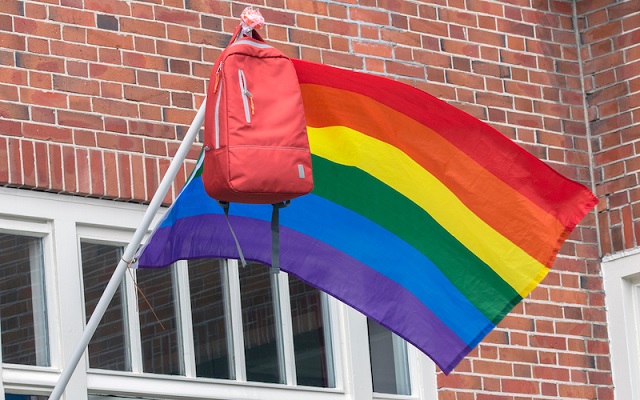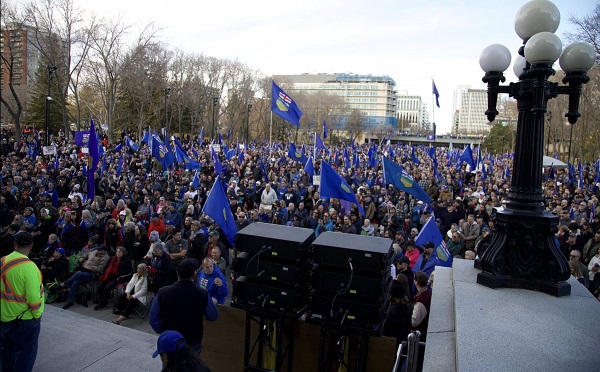Education
‘Sex-ed’ group refuses to release inappropriate material shown in New Brunswick schools: report

From LifeSiteNews
Rebel News is reporting that sex ‘education’ group HPV Global Action, which was banned by the province of New Brunswick for giving inappropriate presentations to school children, is refusing its request to release the material for public viewing.
A Quebec-based sex “education” group has reportedly refused to release the inappropriate material it showed to New Brunswick school children, for which it was banned from giving presentations by the province’s premier.
According to Rebel News’ Sheila Gunn Reid, on September 25 she was notified by the government that the Quebec-based sex “education” group HPV Global Action had filed a complaint to prevent the outlet from obtaining the group’s material which led to its province-wide banning in New Brunswick.
Reid explained that following the group being banned by New Brunswick Premier Blaine Higgs, she “filed an access-to-information request with the New Brunswick Ministry of Education” in an “effort to see the full content.” Instead of being given access to the material, Reid posted the response she got from the government, showing that the group has filed a complaint to attempt to block the disclosure of the documents.
The group’s refusal to show their material comes after the same content was shown to students in Grade 6 through Grade 12 (roughly aged 11 to 18) in May. One slide of the presentation, shared by Higgs, contained disturbing questions about pornography, masturbation and anal “sex.” Along with sharing the slide, Higgs announced he had taken immediate action to ban the group from provincial schools.
“To say I am furious would be a gross understatement,” Higgs declared at the time, adding that the group had been banned “effective immediately.”
HPV Global Action‘s reported refusal to disclose material it shared with children seems to be a trend among LGBT activists who routinely advocate for secrecy, even from parents.
In fact, certain school boards in provinces such as Ontario have official policies in place directing teachers not inform parents about their own children’s gender confusion, or desire to go by a different name or pronouns at school.
While the provinces of New Brunswick, Saskatchewan and Alberta have all taken steps toward keeping parents informed about their children and what is being taught to them, the efforts are routinely met by opposition, and in the case of Saskatchewan even legal action, by pro-LGBT groups, who desire to keep parents in the dark.
Alberta
Premier Smith sending teachers back to school and setting up classroom complexity task force

Taking action on classroom complexity
As schools reopen, Alberta’s government is taking action by appointing a class size and complexity task force to meet the challenge of increasingly complex classrooms.
Across Alberta, teachers are seeing more students with diverse learning needs and behavioural challenges, while incidents of classroom aggression are rising. To address these challenges head on, and in response to concerns raised by teachers, Alberta’s government will be appointing a Class Size and Complexity Task Force.
We recently formed the Aggression and Complexity in Schools Action Team to identify practical classroom focused solutions. Alberta’s government has received the action team’s draft final report and will use its recommendations to create a roadmap for safer classrooms. Alberta’s government will release the final report, and the task force will implement solutions, work with school boards to gather more data on classroom complexity and begin work to replace the 2004 Standards for Special Education.
“Teachers have made it clear that addressing classroom complexity and safety are among the most critical improvements needed in our education system. We are taking real action to meet those needs by strengthening classroom supports, hiring more teachers and educational assistants, and acting on the recommendations of the Aggression and Complexity in Schools Action Team. Parents, teachers and students all want the same thing – safe and supportive classrooms where every child can succeed.”
Teachers are vital to the success of Alberta’s education system. Over the next three years, school boards will be provided with funding to hire 3,000 teachers and 1,500 new education assistants to support students with complex needs. These funds may also be allocated to additional student support through assessments for complex needs, occupational therapy, physiotherapy or speech-language pathology, and other in-the-classroom supports.
“No teacher should ever be harmed while doing their job. We know that aggressive incidents have gone up sharply in recent years, and classrooms are becoming more complex. That’s why we’re doubling down on efforts to make classrooms safer and to give extra support to students who need it. Our goal is to create learning environments where every student can succeed.”
In November, Alberta’s government will work with school boards to gather information and data about class sizes and composition to ensure students are receiving the support they need. Information will be made available as soon as it is available and will be released annually thereafter.
Quick facts
- Between July and September 2025, the action team conducted engagement sessions with teachers, education partners and school boards through in-person and virtual sessions.
- This included front-line educators, families, disability organizations, community agencies, early learning experts and social service professionals.
- Budget 2025 included $55 million to help address classroom complexity – a 20 per cent increase from the previous year.
Getting Alberta’s kids back to school
If passed, Bill 2, the Back to School Act, will restore stability in Alberta’s education system and ensure students can return to learning without further disruption.
The ongoing teachers’ strike has disrupted classrooms across Alberta, setting back student learning and deepening achievement gaps. Each day schools remain closed, students lose critical instructional time, routine and support. This proposed legislation will end the strike and establish reasonable terms for a new teacher collective agreement.
“This strike has gone on long enough. It’s clear there’s no path forward unless we act. The Back to School Act refocuses everyone on what matters most, the education of Alberta’s students. Bill 2 puts students back at the centre of our system, while we continue to work with teachers and families to build lasting stability in Alberta’s schools.”
The Back to School Act legislates the terms of the September 2025 tentative agreement, which provided a 12 per cent salary increase over four years, additional market adjustments of up to 17 per cent for most teachers, and the hiring of 3,000 teachers and 1,500 educational assistants. The collective agreement will be in effect from Sept. 1, 2024, to Aug. 31, 2028.
“The time for labour stability is now. This legislation provides a positive path forward despite an interrupted school year. This is a necessary step and the most responsible decision for kids, teachers and parents. If Bill 2 is passed, it is my hope that classes will resume as soon as Wednesday, October 29.”
The last deal put on the table by the Alberta Teachers’ Association demanded an additional $2 billion from government. This was a clear display that the union had no intention to bargain in a reasonable manner with the government and present a fair offer.
“We believe invoking the notwithstanding clause is a necessary measure to end the undue hardship caused by the teacher strike. This strike has reached a point that is causing irreparable harm on student learning. Our government will not hesitate to use every available legal tool in defence of students.”
This legislation is the only responsible path forward to restore stability, protect students and ensure Alberta’s classrooms focus back on learning. Alberta’s government remains fully committed to strengthening the education system, supporting teachers, and putting the success and well-being of students at the heart of every decision made.
Key facts
- Bill 2 would end the province-wide teachers’ strike and legislates a new collective agreement.
- The agreement covers Sept. 1, 2024, to Aug. 31, 2028 and provides:
- A 12 per cent salary increase over four years.
- Additional market adjustments of up to 17 per cent for 95 per cent of members.
- 3,000 new teachers and 1,500 educational assistants to reduce class sizes and enhance support.
- These terms reflect the September 2025 tentative agreement recommended by the Alberta Teachers’ Association leadership.
- The legislation includes financial penalties for non-compliance and suspends local bargaining during the agreement to ensure labour stability through 2028.
Alberta
Petition threatens independent school funding in Alberta

From the Fraser Institute
Recently, amid the backdrop of a teacher strike, an Alberta high school teacher began collecting signatures for a petition to end government funding of independent schools in the province. If she gets enough people to sign—10 per cent of the number of Albertans who voted in the last provincial election—Elections Alberta will consider launching a referendum about the issue.
In other words, the critical funding many Alberta families rely on for their children’s educational needs may be in jeopardy.
In Alberta, the provincial government partially funds independent schools and charter schools. The Alberta Teachers’ Association (ATA), whose members are currently on strike, opposes government funding of independent and charter schools.
But kids are not one-size-fits-all, and schools should reflect that reality, particularly in light of today’s increasing classroom complexity where different kids have different needs. Unlike government-run public schools, independent schools and charter schools have the flexibility to innovate and find creative ways to help students thrive.
And things aren’t going very well for all kids or teachers in government-run pubic school classrooms. According to the ATA, 93 per cent of teachers report encountering some form of aggression or violence at school, most often from students. Additionally, 85 per cent of unionized teachers face an increase in cognitive, social/emotional and behavioural issues in their classrooms. In 2020, one-quarter of students in Edmonton’s government-run public schools were just learning English, and immigration to Canada—and Alberta especially—has exploded since then. It’s not easy to teach a classroom of kids where a significant proportion do not speak English, many have learning disabilities or exceptional needs, and a few have severe behavioural problems.
Not surprisingly, demand for independent schools in Alberta is growing because many of these schools are designed for students with special needs, Autism, severe learning disabilities and ADHD. Some independent schools cater to students just learning English while others offer cultural focuses, expanded outdoor time, gifted learning and much more.
Which takes us back to the new petition—yet the latest attempt to defund independent schools in Alberta.
Wealthy families will always have school choice. But if the Alberta government wants low-income and middle-class kids to have the ability to access schools that fit them, too, it’s crucial to maintain—or better yet, increase—its support for independent and charter schools.
Consider a fictional Alberta family: the Millers. Their daughter, Lucy, is struggling at her local government-run public school. Her reading is below grade level and she’s being bullied. It’s affecting her self-esteem, her sleep and her overall wellbeing. The Millers pay their taxes. They don’t take vacations, they rent, and they haven’t upgraded their cars in many years. They can’t afford to pay full tuition for Lucy to attend an independent school that offers the approach to education she needs to succeed. However, because the Alberta government partially funds independent schools—which essentially means a portion of the Miller family’s tax dollars follow Lucy to the school of their choice—they’re able to afford the tuition.
The familiar refrain from opponents is that taxpayers shouldn’t pay for independent school tuition. But in fact, if you’re concerned about taxpayers, you should encourage school choice. If Lucy attends a government-run public school, taxpayers pay 100 per cent of her education costs. But if she attends an independent or charter school, taxpayers only pay a portion of the costs while her parents pay the rest. That’s why research shows that school choice saves tax dollars.
If you’re a parent with a child in a government-run public school in Alberta, you now must deal with another teacher strike. If you have a child in an independent or charter school, however, it’s business as usual. If Albertans are ever asked to vote on whether or not to end government funding for independent schools, they should remember that students are the most important stakeholder in education. And providing parents more choices in education is the solution, not the problem.
-

 Business1 day ago
Business1 day agoTrans Mountain executive says it’s time to fix the system, expand access, and think like a nation builder
-

 Alberta2 days ago
Alberta2 days agoPremier Smith sending teachers back to school and setting up classroom complexity task force
-

 Crime2 days ago
Crime2 days agoSuspect caught trying to flee France after $100 million Louvre jewel robbery
-

 Addictions1 day ago
Addictions1 day agoThe Shaky Science Behind Harm Reduction and Pediatric Gender Medicine
-

 Alberta2 days ago
Alberta2 days agoThousands of Albertans march to demand independence from Canada
-

 Business1 day ago
Business1 day agoClean energy transition price tag over $150 billion and climbing, with very little to show for it
-

 Business1 day ago
Business1 day agoFlying saucers, crystal paperweights and branded apples: inside the feds’ promotional merch splurge
-

 Business1 day ago
Business1 day agoCanada’s combative trade tactics are backfiring










